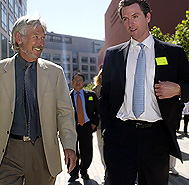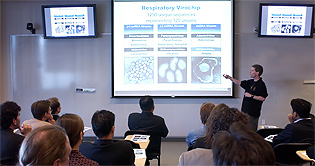Mayor Newsom and Young Global Leaders Visit UCSF Mission Bay
Led by San Francisco Mayor Gavin Newsom, more than two dozen members of the Forum of Young Global Leaders got a close-up view of leading-edge science yesterday at the UCSF Mission Bay campus.
 (See video)
(See video)
Newsom, a member of this international offshoot of the World Economic Forum - and one that bills its representatives as some of the "world's most exceptional leaders 40 years of age or younger" - called UCSF Mission Bay a "clustering of the best and brightest minds," and praised its promise as one of the three legs on which the future of San Francisco rests. "It's all about life sciences, biotechnology and green technology."
From their starting point at the Mission Bay Community Center, the group trekked across the Koret Quad to the California Institute for Quantitative Biomedical Research, more commonly known as QB3. Regis Kelly, PhD, director of the institute, served as host for two scientific presentations that showcased the fusion of innovative biological and engineering approaches to the diagnosis and treatment of disease. "Our charge is to make discoveries that are practical for people," Kelly explained.
Amplifying the theme of practicality, Joe DeRisi, PhD, associate professor of biochemistry and biophysics - whose work has included identifying the virus responsible for SARS, as well as his recent discovery of a new virus in prostate tumors - described the impetus and relevance behind his lab's bioengineered virus chips that can simultaneously screen for the more than 22,000 known viruses. "This is advanced diagnostics because we can identify the infectious pathogens causing a disease, as well as discover new ones."
In a dramatic example of the diagnostic relevance of his viral chips, which have yet to be developed commercially, DeRisi recounted the tale of a young female patient who was near death with a mysterious respiratory infection. "We were able to identify the virus as parainfluenza 4," a diagnosis that saved the woman's life.
Jay Keasling, PhD, professor of chemical engineering at UC Berkeley, one of the QB3 partner institutions along with UC Santa Cruz and UCSF, spoke of lifesaving discoveries, as well. In his case, the target is malaria and the goal is finding a cheap method for bioengineering the malaria-curing drug known as artemisinin, so that the tens of millions who become infected each year can afford to be treated.
"The current dose cost is $2.50. Our technique [which employs the bacterium E. coli as a genetic incubator] can reduce that to 21 cents," Keasling promised. "This is what synthetic biology is all about. We build a chemical factory inside a microbe and engineer chemical synthesis."
Keasling hopes that the first distributable versions of the synthetically engineered artemisinin will be on the global market by 2009. "We're working on it 24/7," he assured the audience.
 (See video)
(See video)Newsom, a member of this international offshoot of the World Economic Forum - and one that bills its representatives as some of the "world's most exceptional leaders 40 years of age or younger" - called UCSF Mission Bay a "clustering of the best and brightest minds," and praised its promise as one of the three legs on which the future of San Francisco rests. "It's all about life sciences, biotechnology and green technology."
 |
| Regis Kelly, director of QB3, leads San Francisco Mayor Gavin Newsom on a tour through health sciences campus at Mission Bay. |
From their starting point at the Mission Bay Community Center, the group trekked across the Koret Quad to the California Institute for Quantitative Biomedical Research, more commonly known as QB3. Regis Kelly, PhD, director of the institute, served as host for two scientific presentations that showcased the fusion of innovative biological and engineering approaches to the diagnosis and treatment of disease. "Our charge is to make discoveries that are practical for people," Kelly explained.
Amplifying the theme of practicality, Joe DeRisi, PhD, associate professor of biochemistry and biophysics - whose work has included identifying the virus responsible for SARS, as well as his recent discovery of a new virus in prostate tumors - described the impetus and relevance behind his lab's bioengineered virus chips that can simultaneously screen for the more than 22,000 known viruses. "This is advanced diagnostics because we can identify the infectious pathogens causing a disease, as well as discover new ones."
 |
| Joe DeRisi, professor of biochemistry and biophyics, explains his virus-detecting research to a group of Young Global Leaders, including Mayor Gavin Newsom. Photos by Christine Jegan. |